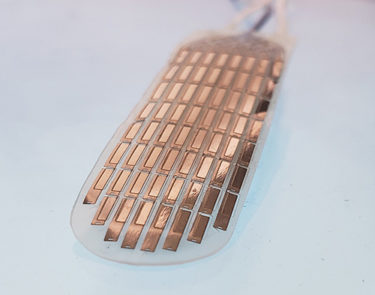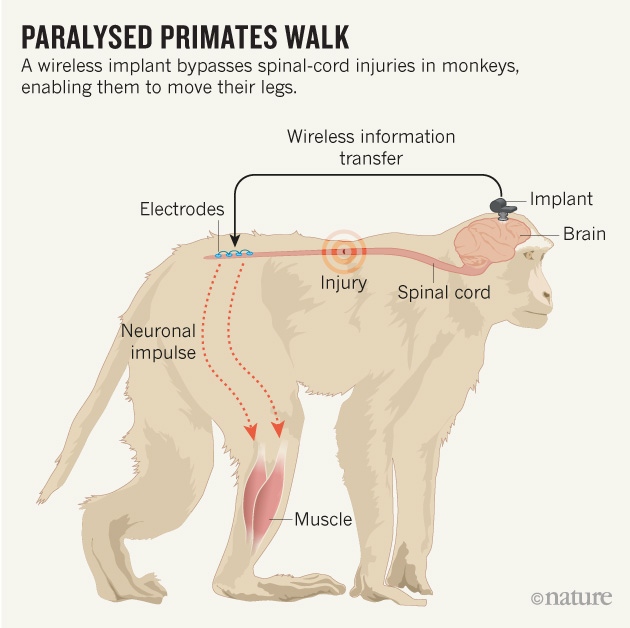DARPA launches a new program designed to restore natural functions after a soldier suffers a spinal cord injury, which comes three years after paralyzed monkeys were made to walk.
“to restore natural functions such as breathing, bowel and bladder control, movement, touch, and proprioception that can be lost when the spinal cord is damaged”
Bridging the Gap Plus (BG+) is the Defense Advanced Research Projects Agency’s (DARPA’s) latest 5-year program that combines AI, neurotech, and biosensors in an attempt to heal spinal cords at the wound site.
Nowhere in the announcement did DARPA specifically mention that it was looking to help its soldiers walk again; however, all the language is pointing in that direction.

Electrode arrays like this one will be used to create an Intelligent Spine Interface aimed at one day helping restore function for people with spinal cord injuries. Image source Brown University”
By interfacing with the nervous system, one goal of the BG+ program is “to restore natural functions such as breathing, bowel and bladder control, movement, touch, and proprioception that can be lost when the spinal cord is damaged [emphasis mine].”
With a $6.3 million grant from DARPA this month, Brown University is simultaneously conducting a two-year research to develop an intelligent spinal interface “that marries implanted electrodes with machine learning to potentially restore lower-limb motor and sensory control and proprioception to individuals living with paraplegia.”
“We hope that by exploring what signals are generated by the spinal cord, how they relate to activities of daily living and how electrical modulation of the spinal cord impacts these signals, we will inform future designs of therapeutic technologies,” said Brown University lead scientist Dr. David Borton.
“At the end of the first year, the researchers will work with volunteers living with paraplegia to test a percutaneous interface system with the goal of restoring movement and sensation. By the end of the second year, the researchers plan to test a fully implanted system,” according to DARPA.
Paralyzed Monkeys with Spinal Cord Injuries Can Walk!
The technology already exists to undo paralysis caused by spinal cord injuries. In November of 2016 Nature reported that “Brain implants allow paralysed monkeys to walk.”
However, according to Swiss neuroscientist Gregoire Courtine, replicating the same experiment on humans is more complex because human brains are more difficult to decode.

A wireless implant bypasses spinal-cord injuries in monkeys, enabling them to move their legs. Image source Nature
For now, DARPA’s BG+ program is focusing on “networked interface devices that communicate with the nervous system or relevant end organs to restore physiological function. DARPA is especially interested in recovering voluntary and involuntary nervous system functions such as bladder control and respiration.”
Read More: Bioengineering soldiers for smart, adaptive wound recovery
What fascinates me about DARPA is that a lot of technology that becomes mainstream and available for commercial use has its beginnings in the military, like that which powers Amazon’s Alexa and similar devices.
The possibility of allowing those who were paralyzed to walk again would be considered a miracle by anyone throughout thousands of years of human history, and here we are witnessing real progress being made.
BG+ program manager Dr. Al Emondi said in a statement that “Physicians have very little information about what actually goes on in real time at the injury site. DARPA aims to change that using bioelectronic interfaces that measure biomarkers directly related to the injury.”
Read More: What the ‘biomarker revolution’ means for personalized, precision medicine
“Once we know what’s taking place at the spinal cord from moment to moment, we think it will be possible to deliver intelligent interventions that optimize our ability to preserve and reinforce neural communications during the acute phase of spinal cord injury,” he added.
Dr. Emondi also led DARPA’s Next-Generation Nonsurgical Neurotechnology (N3) program.
Further Spinal Cord Injury Research Developments
In other developments the University of Louisville reported last year, “Two research participants living with traumatic, motor complete spinal cord injury are able to walk over ground thanks to epidural stimulation paired with daily locomotor training.”
“This research demonstrates that some brain-to-spine connectivity may be restored years after a spinal cord injury as these participants living with motor complete paralysis were able to walk, stand, regain trunk mobility and recover a number of motor functions without physical assistance when using the epidural stimulator and maintaining focus to take steps,” said Susan Harkema, PhD.
The research mentioned in this article doesn’t even begin to cover the massive scope of programs taking place across universities and government-funded agencies worldwide.
For the first time in our human history we have begun taking giant steps forward in restoring limb function for people suffering from spinal cord injuries.












